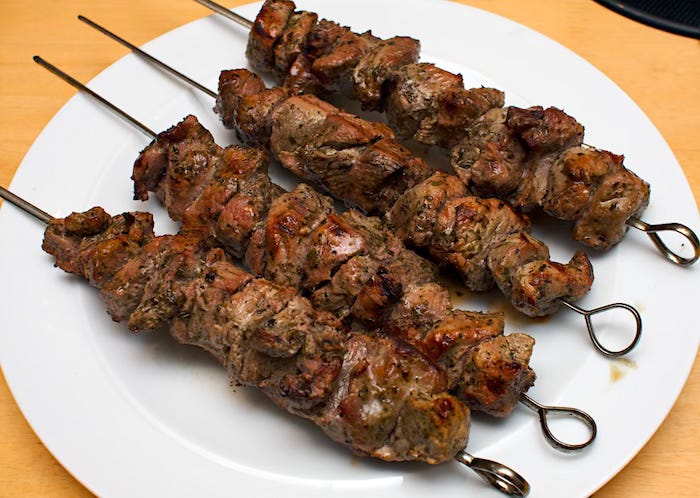The Iliad was a Documentary (1)
Obeliskos
οἳ δʼ ὅτε δὴ κλισίῃσιν ἐν Ἀτρεΐδαο γένοντο,
τοῖσι δὲ βοῦν ἱέρευσεν ἄναξ ἀνδρῶν Ἀγαμέμνων
ἄρσενα πενταέτηρον ὑπερμενέϊ Κρονίωνι.
τὸν δέρον ἀμφί θʼ ἕπον, καί μιν διέχευαν ἅπαντα,
μίστυλλόν τʼ ἄρʼ ἐπισταμένως πεῖράν τʼ ὀβελοῖσιν,
ὄπτησάν τε περιφραδέως, ἐρύσαντό τε πάντα.
αὐτὰρ ἐπεὶ παύσαντο πόνου τετύκοντό τε δαῖτα,
δαίνυντʼ, οὐδέ τι θυμὸς ἐδεύετο δαιτὸς ἐΐσης·When they were in Agamemnon’s quarters
The warlord sacrificed an ox for them,
A bull of five years, to almighty Cronion.
They flayed and dressed it, jointed the limbs
And sliced them skillfully, skewered the pieces,
Roasted them carefully, and drew them off the spits.
When they were done and the feast was ready,
Feast they did, and no one lacked an equal share.
— Iliad 7.313-7.320 (S. Lombardo, trans.)
If this trip and its blogs and videos has any kind of thesis, it is that a good way to learn about ancient Greece is to engage with the Greece of today, the landscape and the people, outside of archaeological sites and museums.
In Book 7 of the Iliad we get a formulaic dining scene, where a King gives a feast for his community (in this case, the army).
Our first stop after Thessaloniki was with our friends George and Georgia, at their house in Gavalou, in Makryneia, Aetolia-Acarnania (the western side of the mainland). That night, they brought us to a community festival, sponsored by the tireless mayor of Gavalou, Andreas Goulas.
This was the food. Homer doesn’t say “souvlaki”, but the poem is clearly talking about the same thing.
The skewers are called obeliskoi (ὀβελίσκοι).
Every dinner we ate in Gavalou featured meat of one kind or another cooked and served on obeliskoi. Just like meals in the Iliad!
Evidently the kebab-skewer is a powerful cultural touchstone. “Obelisk” has many meanings. It is used for the shape of, e.g., the Washington Monument.
Bringing it back to Homer, it is the name for a particular symbol written in the margins of many Byzantine manuscripts of the Iliad. Like this:
There is a straight line in the margin to the left of Book 1, line 474, on Folio 21, recto, of manuscript Venetus A: Marcianus Graecus Z. 454 (= 822). This is an obeliskos.
It indicates that the great Alexandrian scholar Aristarchus of Samothrace in his edition of the Iliad indicated that this line was not authentically Homeric but had crept in somehow or another.
οἳ δὲ πανημέριοι μολπῇ θεὸν ἱλάσκοντο
καλὸν ἀείδοντες παιήονα κοῦροι Ἀχαιῶν
μέλποντες ἑκάεργον· ὃ δὲ φρένα τέρπετʼ ἀκούων.The young men of the Achaeans all day long propititiated [the God] with dance singing a beautifull paean, celebrating the far-working God. And he delighted in his heart to hear it.
— Iliad 1.472-1.474
Aristarchus’s objection has to do with wordiness, where the young men are propitiating and pleasing and delighting the God; also, there is some confusion over “paean” (the song) and “Paean” (another name for Apollo).
The image of the obeliskos, here, is that you skewer the offending line so you can lift it out (but Aristarchus did not actually remove it, because was unwilling to throw anything away).
Back to the festival at Gavalou, Amy and I can assure you that no one lacked an equal share!
Peripatos: Travels with Amy and Chris Blackwell © 2024 by Amy G. Hackney Blackwell & Christopher W. Blackwell is licensed under CC BY-NC-SA 4.0.






